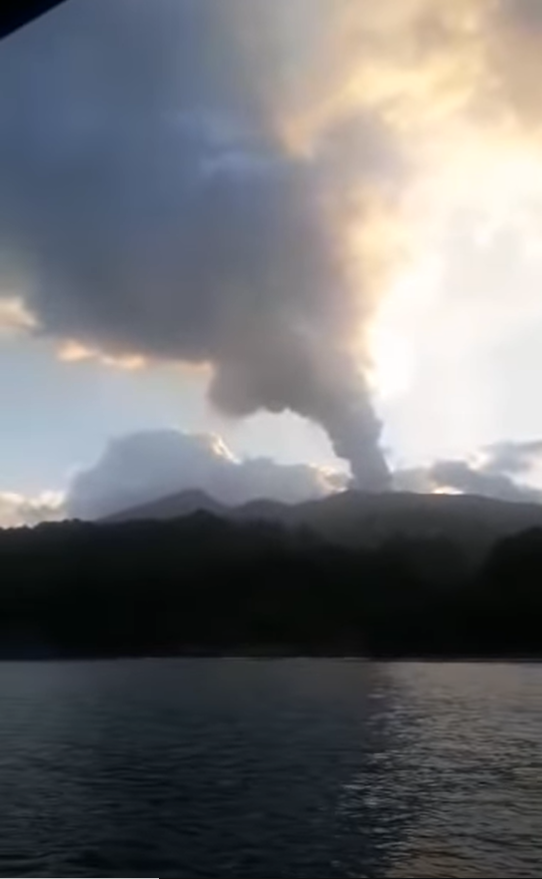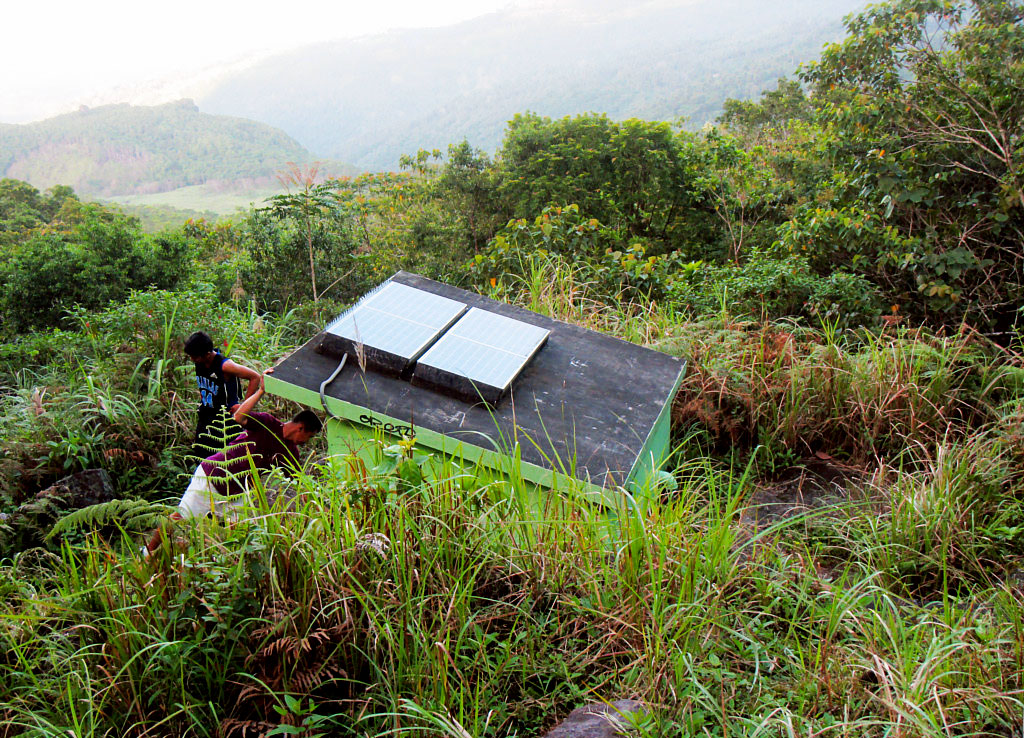|
Peléan Eruption
Peléan eruptions are a type of volcanic eruption. They can occur when viscous magma, typically of rhyolitic or andesitic type, is involved, and share some similarities with Vulcanian eruptions. The most important characteristic of a Peléan eruption is the presence of a glowing avalanche of hot volcanic ash, called a pyroclastic flow. Formation of lava domes is another characteristic. Short flows of ash or creation of pumice cones may be observed as well. The initial phases of eruption are characterized by pyroclastic flows. The tephra deposits have lower volume and range than the corresponding Plinian and Vulcanian eruptions. The viscous magma then forms a steep-sided dome or volcanic spine in the volcano's vent. The dome may later collapse, resulting in flows of ash and hot blocks. The eruption cycle is usually completed in a few years, but in some cases may continue for decades, like in the case of Santiaguito. The 1902 eruption of Mount Pelée ( VEI-4) is the first descri ... [...More Info...] [...Related Items...] OR: [Wikipedia] [Google] [Baidu] |
Lava Spine
Lava is molten or partially molten rock (magma) that has been expelled from the interior of a terrestrial planet (such as Earth) or a moon onto its surface. Lava may be erupted at a volcano or through a fracture in the crust, on land or underwater, usually at temperatures from . The volcanic rock resulting from subsequent cooling is also often called ''lava''. A lava flow is an outpouring of lava during an effusive eruption. (An explosive eruption, by contrast, produces a mixture of volcanic ash and other fragments called tephra, not lava flows.) The viscosity of most lava is about that of ketchup, roughly 10,000 to 100,000 times that of water. Even so, lava can flow great distances before cooling causes it to solidify, because lava exposed to air quickly develops a solid crust that insulates the remaining liquid lava, helping to keep it hot and inviscid enough to continue flowing. The word ''lava'' comes from Italian and is probably derived from the Latin word ''labes'', ... [...More Info...] [...Related Items...] OR: [Wikipedia] [Google] [Baidu] |
Mount Vesuvius
Mount Vesuvius ( ; it, Vesuvio ; nap, 'O Vesuvio , also or ; la, Vesuvius , also , or ) is a somma- stratovolcano located on the Gulf of Naples in Campania, Italy, about east of Naples and a short distance from the shore. It is one of several volcanoes forming the Campanian volcanic arc. Vesuvius consists of a large cone partially encircled by the steep rim of a summit caldera, resulting from the collapse of an earlier, much higher structure. The eruption of Mount Vesuvius in AD 79 destroyed the Roman cities of Pompeii, Herculaneum, Oplontis, Stabiae, and several other settlements. The eruption ejected a cloud of stones, ashes and volcanic gases to a height of , erupting molten rock and pulverized pumice at the rate of per second. More than 1,000 people are thought to have died in the eruption, though the exact toll is unknown. The only surviving eyewitness account of the event consists of two letters by Pliny the Younger to the historian Tacitus. Vesuvi ... [...More Info...] [...Related Items...] OR: [Wikipedia] [Google] [Baidu] |
2021 Eruption Of La Soufrière
La Soufrière, a stratovolcano on the Caribbean island of Saint Vincent in Saint Vincent and the Grenadines, began an effusive eruption on 27 December 2020. On 9 April 2021 there was an explosive eruption, and the volcano "continued to erupt explosively" over the following days, with pyroclastic flows. The activity pattern of the eruption was comparable to that of the event that occurred in 1902, which had a Volcanic Explosivity Index (VEI) of 4. The volcano is known to have erupted 23 times in the last 4,000 years, and had been dormant since 1979. Evacuation of the inhabitants of the island began when the explosive eruptions started. Many countries, including islands in the region, and organisations provided relief and support. Services such as electricity and water were severely affected. Emitted ash and sulfur dioxide gas affected the population. The COVID-19 pandemic made evacuation more difficult, requiring usual COVID-19 precautions to avoid outbreaks. Effusive phas ... [...More Info...] [...Related Items...] OR: [Wikipedia] [Google] [Baidu] |
Mayon Volcano
Mayon ( bcl, Bulkan Mayon; tl, Bulkang Mayon, ), also known as Mount Mayon and Mayon Volcano ( es, Monte Mayón, Volcán Mayón), is an active stratovolcano in the province of Albay in Bicol, Philippines. A popular tourist spot, it is renowned for its "perfect cone" because of its symmetric conical shape, and is regarded as very sacred in Philippine mythology. The volcano with its surrounding landscape was declared a national park on July 20, 1938, the first in the nation. It was reclassified as a natural park and renamed the Mayon Volcano Natural Park in 2000."Protected Areas in Region 5" . Protected Areas and Wildlife Bureau. Retrieved on October 15, 2011. It is the centerpiece of the Albay Biosphere Reserve, declared by |
1951 Eruption Of Mount Lamington
In early January 1951, a series of minor explosions and earthquakes rocked Mount Lamington, a volcano in Oro Province, Territory of Papua and New Guinea. Prior to the eruption, Mount Lamington was not recognized as a volcano due to the absence of historically-recorded eruptions and dense vegetation cover. From January 15, volcanic activity intensified, and tall eruption plumes were generated. The largest eruption occurred on the morning of January 21 when a thick black plume of ash rose into the atmosphere. The eruption collapsed a lava dome and produced a lethal pyroclastic flow that killed 2,942–3,466 people. In the years after the eruption, new lava domes formed and collapsed in succession. Activity persisted until July 1956. The eruption is the deadliest natural disaster in Australian history, as the region was under the rule of the Government of Australia. Tectonic setting Volcanism in Papua New Guinea is due to the ongoing subduction of oceanic crust beneath the island ... [...More Info...] [...Related Items...] OR: [Wikipedia] [Google] [Baidu] |
Hibok-Hibok
Mount Hibok-Hibok (also known as Catarman Volcano) is a stratovolcano on Camiguin Island in the Philippines. It is one of the active volcanoes in the country and part of the Pacific ring of fire. Description Volcanologists classify Hibok-Hibok or Catarman Volcano as a stratovolcano and dome complex with an elevation of and a base diameter of . It has six hot springs (Ardent Spring, Tangob, Bugong, Tagdo, Naasag and Kiyab), three craters (Kanangkaan Crater, site of the 1948 eruption; Itum Crater, site of 1949 eruption, and Ilihan Crater, site of 1950 eruption). Its adjacent volcanic edifices are Mount Vulcan, high, northwest of Hibok-Hibok; Mount Mambajao, center of Camiguin; Mount Guinsiliban high, southernmost Camiguin; Mount Butay ; and Mount Uhay, N of Mount Guinsiliban. There are also domes and cones at Campana Hill, Minokol Hill, Tres Marias Hill, Mount Carling, Mount Tibane, and Piyakong Hill. Mount Timpoong and Hibok-Hibok form the two major landmarks within the ... [...More Info...] [...Related Items...] OR: [Wikipedia] [Google] [Baidu] |
1902 Eruption Of Mount Pelée
The 1902 eruption of Mount Pelée was a volcanic eruption on the island of Martinique in the Lesser Antilles Volcanic Arc of the eastern Caribbean, which was one of the deadliest eruptions in recorded history. Eruptive activity began on 23 April as a series of phreatic explosions from the summit of Mount Pelée. Within days, the vigor of the explosions exceeded anything witnessed since the island was settled by Europeans. The intensity then subsided for a few days until early May, when the explosions increased again. Lightning laced the eruption clouds and trade winds dumped ash on villages to the west. Heavy ash fell, sometimes causing total darkness. Some of the afflicted residents panicked and headed for the perceived safety of larger settlements, especially Saint-Pierre, about south of Pelée's summit. Saint-Pierre received its first ash fall on 3 May. Mount Pelée remained relatively quiet until the afternoon of 5 May when a mudflow swept down a river on the southwest fl ... [...More Info...] [...Related Items...] OR: [Wikipedia] [Google] [Baidu] |
Types Of Volcanic Eruptions
Several types of volcanic eruptions—during which lava, tephra (ash, lapilli, volcanic bombs and volcanic blocks), and assorted gases are expelled from a volcanic vent or fissure—have been distinguished by volcanologists. These are often named after famous volcanoes where that type of behavior has been observed. Some volcanoes may exhibit only one characteristic type of eruption during a period of activity, while others may display an entire sequence of types all in one eruptive series. There are three different types of eruptions: * Magmatic eruptions are the most well-observed type of eruption. They involve the decompression of gas within magma that propels it forward. * Phreatic eruptions are driven by the superheating of steam due to the close proximity of magma. This type exhibits no magmatic release, instead causing the granulation of existing rock. * Phreatomagmatic eruptions are driven by the direct interaction of magma and water, as opposed to phreatic ... [...More Info...] [...Related Items...] OR: [Wikipedia] [Google] [Baidu] |







